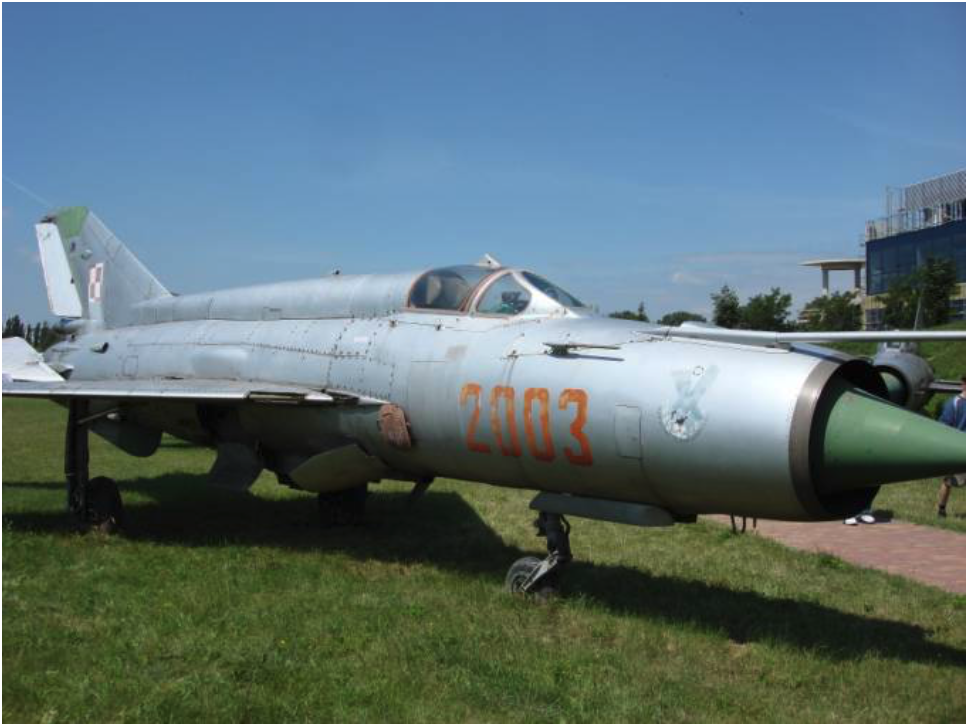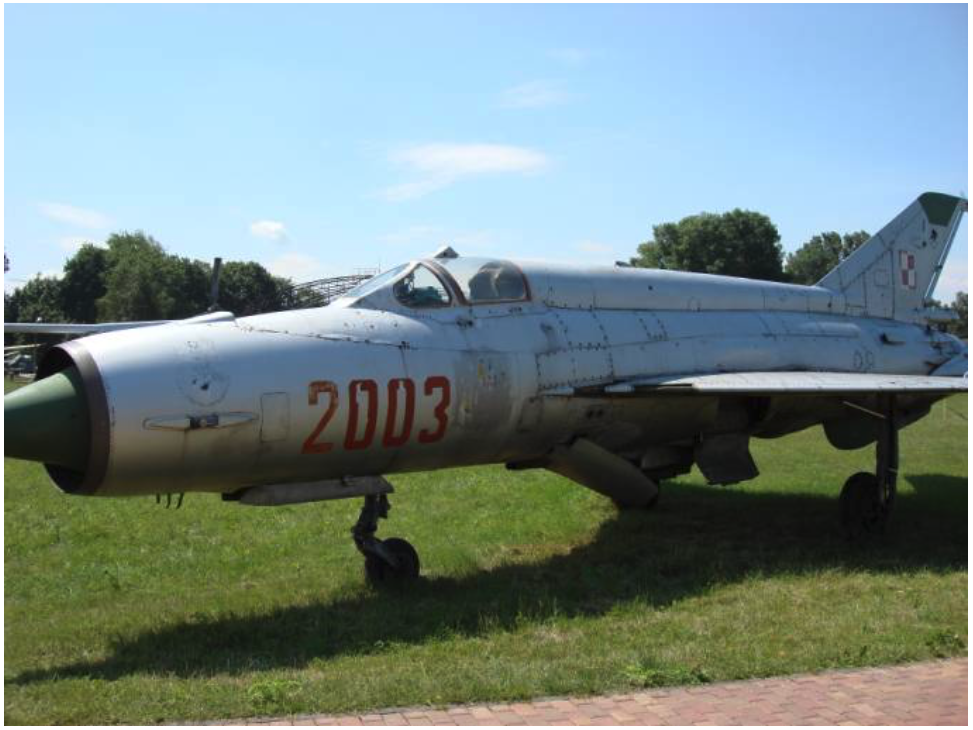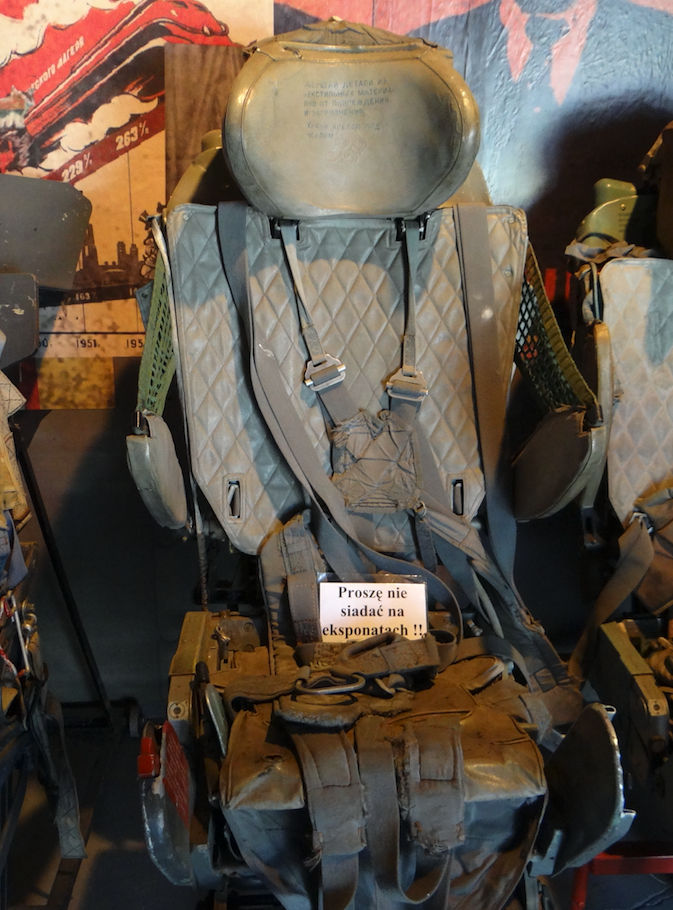Kraków 2017-09-17
The tragedy of the MiG-21 M nb 1902 on September 22, 1982.
Pilot hero Stanisław Pawlak.
On September 22, 1982, Lieutenant Engineer Pilot Stanisław Pawlak died during a training flight. For all the inhabitants of Rogowo, a hero who saved many lives thanks to his efforts.
The flight was performed on the MiG-21 M nb 1902 aircraft. MiG-21 M aircraft belong to the third generation of Mikojan and Guriewicz MiG-21 fighters. The MiG-21 M (SM) type 15 aircraft, E-7 SM, was developed in 1968, based on the reconnaissance MiG-21 R. Four armament nodes were installed under the wings, with a lifting capacity increased to 1,300 kg. A two-barrel GSz-23 Ł cannon with a supply of 200 rounds was permanently installed in the airframe. The aircraft is equipped with an R-13-300 engine with a thrust of 1 x 3,990 kG without afterburning and 1 x 6,360 kG with afterburning. The R-832 M communication radio station appeared. The airframe was equipped with the SPS-141 E WRe (electronic warfare) tank and ASO-21 ejectors with PRP-26 cartridges and PPI-26 thermal traps.
The MiG-21 M is a depleted version of the MiG-21 SM. The MiG-21 M type 96, E-7 M aircraft received the R-11 F2S-300 or R-11 F2SK-300 engine, the R-802 W radio station. The aircraft were produced in Moscow only for export, in 1968-1971. In 1971, the license was sold to India.
MiG-21 M nb 2003 aircraft. Pilot Stanisław Pawlak was flying on such an aircraft.
On December 30, 1969, Poland received the first 6 pieces of the new MiG-21 M aircraft, which went to CSL (Aviation Training Center) in Modlin. Their introduction made it possible to decommission the first supersonic aircraft of the Polish Aviation MiG-19 P/PM and MiG-21 F-13. Deliveries were completed in 1971. Total 36 pieces. The first combat unit to receive MiG-21 M aircraft was the 41st PLM in Malbork. The next combat units are the 1st PLM in Mińsk Mazowiecki, the 26th PLM in Zegrze Pomorskie, the 9th PLM in Debrzno. In 1990, the aircraft were still in service in the number of 27 pieces, and in 2000 there were still 15 pieces. During 30 years of operation, 12 machines were lost in accidents (1 in a catastrophe, 9 in breakdowns, 2 damaged). Exactly after 30 years of service, the MiG-21 M aircraft were withdrawn from flights and deleted. The MiG-21 M nb 1902 aircraft No. 961902 was received by Poland in June 1970. The aircraft was handed over to the 9th PLM in Debrzno.
Stanisław Pawlak was born in 1953. At the time of the tragedy, he was only 29 years old. He was a graduate of the Military Academy of Aviation "School of Eaglets" in Dęblin, obtaining the title of pilot engineer. He was a pilot of the 9th Fighter Aviation Regiment in Debrzno and had a 2nd class license. On MiG-21 aircraft, he had 240 hours of flight time.
September 22, 1982 was a flying day in the regiment. The pre-flight check-in took place at 8:00. Two flights were planned; morning and afternoon. Flights started at 9:30. The pilots performed their tasks in difficult daytime weather conditions. The task was carried out in the triangle Bydgoszcz, Gniezno, Chodzież. In the task zone, the cloud base did not exceed 300 m, and in places it was much lower. Ground-based radar stations were used in the exercise.
On that day, lieutenant pilot Stanisław Pawlak was flying the MiG-21 nb 1902 aircraft, then a twelve-year-old machine, which was after a medium overhaul, carried out two years earlier. The 240-hour raid on the MiG-21 that pilot Stanisław Pawlak had on his lap was already a big raid. It should be remembered that the flight time was then counted from the start of the take-off run to the end of the roll-out after touchdown. Taxiing was not included in the raid. Currently, the time is counted from the moment the engine is started until it is turned off. At that time, flights on MiG-21 aircraft were relatively short and did not exceed one hour of task performance. The MiG-21 M aircraft only had a maximum range of 1,850 km. So, 240 hours of flying time is a lot of experience.
Lieutenant pilot Stanisław Pawlak took off. He flew to the task zone located about 100 km south of Debrzno. He radioed in to the navigator conducting the exercise and proceeded to complete the task. He reported that he had intercepted the target and was commanded by the navigator: Take out and go to the right. The pilot reported: Got it, moving out. Moments later, the plane hit the ground. This is where official reports end. The MiG-21 aircraft does not have the so-called black boxes. Only conversations conducted over the air were recorded.
In fact, lieutenant pilot Stanisław Pawlak reported the plane’s failure. Eyewitnesses saw a plume of black smoke from the plane through which tongues of fire pierced. The navigator ordered him to catapult himself. Stanisław Pawlak informed the navigator that he saw a large building in front of him, probably a school and a housing estate, so he would try to move the machine over an uninhabited area. He got permission for it. The pilot’s command "I’m leading out" was his last message. The plane with a huge noise flew right over the school and the housing estate. Probably, at that moment, the pilot was pulling the stick with all his might to lift the machine up. He had no time to prepare for catapulting.
The MiG-21 M aircraft has a KM-1 ejection seat, inferior to the KM-1M seats used in the MiG-21 MF aircraft. The KM-1 seat was used in the MiG-21 PFM, S, M, US aircraft and in the early MiG-23 and MiG-25. It has two stabilizing parachutes in the headrest. The main parachute is placed in the back of the seat and the spare in the seat. Parachutes type NAZ-5U or NAZ-7. The seat enables safe ejection at speeds above 130 km/h and below 1,200 km/h. Ceiling from 0 m to the maximum flight altitude of the aircraft. Subsequent experience has shown that a speed of over 200 km/h is needed to safely exit the aircraft. The armchair has two automatic units deciding on the start of the next steps of the rescue cycle: KPA-4 and PPK-2P-405. The KSM-M firing mechanism, together with the bowl and the backrest, is a force element of the chair structure and is designed to give the seat-pilot assembly a translational movement during catapulting. The KSM-M consists of an SM blasting mechanism and a solid-propellant powder rocket motor, whose successive activation ensures that the seat and the pilot are ejected to the appropriate height, while maintaining the permissible overloads. The design of the KM-1 seat is characterized by the fact that the harness of the main parachute is also used to tie the pilot to the seat by means of the belts attracting mechanisms. After catapulting, the speed of the pilot with the seat is 30 m/s. Then the headrest tilts back and releases the parachute backrest. Two stabilizing and speed reducing parachutes deploy successively. The second stabilizing (braking) parachute removes the cover from the main parachute and opens it. The canopy of the main parachute, with an area of 54 square meters, enters the air stream and separates the pilot from the seat. On the starboard side of the seat bowl there are PPK-1P and PPK-2P devices, which, depending on the ejection ceiling or after a certain time, cause the harness locks to open and the pilot to be released from the seat.
Theoretically, Stanisław Pawlak could have saved his life. However, in order to launch safely, several steps had to be taken. It was necessary to take the legs off the T-bar and place them on the footrests and leg grippers in the chair. Release the joystick and throttle, close the helmet visor and grab the seat handle. Catapulting is done by pulling out the double handle located on the seat bowl. The pilot just ran out of time.
The fighter flew over the Rogowa estate and a few seconds later crashed into the ground. At the same time, it caused a huge bang, sticking several meters deep into the ground. The view of the disaster, according to those who saw it, especially from the second floor of the school, resembled the explosion of an atomic bomb. A mushroom formed which caused panic and fear. The crash occurred at 10:29.
The soldiers gathered on the spot had no doubts that Stanisław Pawlak saved the lives of many residents of Rogów and the surrounding area, including dozens of children who were at school at the time. The soldiers worked until the evening of the next day, when all that was left of the plane was already on the cars. The investigation of the accident was carried out by a commission sent from Warsaw. Unfortunately, the accident investigation was unreliable. The report stated: "The cause of the disaster, apart from the terrible weather conditions, poorly recognized in the area of operations, was also the pilot’s error, who lost spatial orientation." Stanisław Pawlak could not defend himself because he was dead. His colleagues were powerless and his family was slandered. His son is fighting bravely for his father’s good name.
Why did this happen? Let us remember that at that time, martial law had been in force in Poland for ten months. The Military Council for National Saving (WRON) ruled, headed by Wojciech Jaruzelski. Just in July 1982, the Citizens’ Militia returned thousands of anti-nation machine guns to military warehouses. Wojciech Jaruzelski has already killed nine miners of the Wujek mine. It is true that Solidarity was outlawed, but Lech Wałęsa and others, during the pseudo-internment, gave lectures to the uniformed services and had fun drinking the best liquors. The communists only wanted to show the world that the situation in the People’s Republic of Poland was stabilizing and that communism was the future.
A thorough investigation of Stanisław Pawlak’s accident required detailed tests and simulations, and this is long and expensive. The remains of the airframe and engine had to be thoroughly examined, because smoke and fire were a fact. But the communists decided that it was better to close the matter as soon as possible.
For the inhabitants of Rogów, Lieutenant Pilot Engineer Stanisław Pawlak is a hero. In the place where the MiG-21 M nb 1902 plane fell, the inhabitants of Rogów erected an obelisk. There is a memorial stone in the square. Every year there are celebrations dedicated to the heroic pilot Stanisław Pawlak. In the Chamber of National Remembrance in Rogów there are memorabilia of the Wielkopolska Uprising, World War II and a section dedicated to the heroic pilot, Stanisław Pawlak. The collection includes a letter from his father and a pilot’s uniform. Councilors are considering naming one of the streets after Stanisław Pawlak.
Written by Karol Placha Hetman



